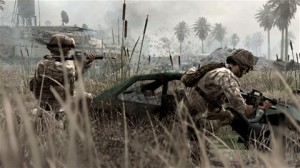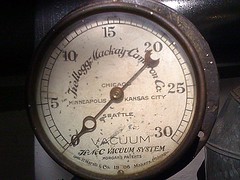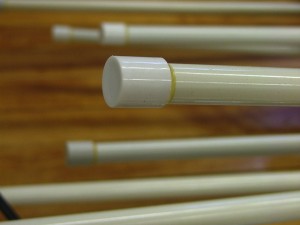The Esquire gamer never shoots for the face.
Wednesday, February 24th, 2010(or: The dire state of video game criticism.)
Stephen Marche in this post and this month’s Esquire claims that Modern Warfare 2 “may be the first protest game.” Even if I amend his sentiment to be “the first wildly successful protest game” (MW2 has set a number of video game sales records) I still can’t get this to parse.

(MW2 screenshot — click to enlarge.)
Marche sees MW2 as a protest for two reasons. First, the game comments on your character’s death by displaying jarring anti-war quotes (“Before you embark on a journey of revenge, dig two graves.” –Confucious).
Second, Stephen Marche is personally confused while playing it (he writes: “I keep asking myself: Why am I here? Whom am I killing?”). I think he believes this is a feeling the game intends to evoke in order to demonstrate the pointlessness of war.
This is the kind of commentary that you get when you put an old-media critic on the spot and ask him something about video games. Given the importance of video games for… well… masculinity, I can see that Esquire magazine (Marche’s employer) would like someone in those pages to write something smart about them. Yet the rest of Marche’s writing on culture is mostly about movies and TV, and it shows. He writes about video games as someone who doesn’t seem to know a thing about them. (The first protest game? Come on!) And he writes a commentary on a particular game (MW2) without spending enough time with it to know that he sounds foolish. Would a television critic write about a TV show without watching it? Yet that’s the state of the art in high-culture game commentary.
Marche seems to have connected MW2 and the Iraq war based on the box art and the introduction. That’s quite a gaffe for a critic– like reviewing a movie based only on the trailer. The game’s storyline is about a war with Russia, and the most jarring and memorable moments are a scene when the player is asked to kill civilians as an undercover operative storming a Russian airport, and several scenes where the player must repel Russian paratroopers from strip malls and mega-mansions in the suburbs of northern Virginia. See a big link to Iraq there, Marche? I didn’t think so.

Red Dawn: The ‘ Burbs (actually MW2; click to enlarge.)
As any player will know, MW2 also quotes Dick Cheney and Donald Rumsfeld, and the jarring anti-war quotes include “Principle is okay up to a certain point, but principle doesn’t do any good if you lose” (Dick Cheney). Earlier games in the Call of Duty series quote Oscar Wilde and that masterful anti-war commentator Lois McMaster Bujold. And as you can already tell, I don’t think the pointlessness and confusion is particularly evoked by MW2. I think Marche would be hard-pressed to find MW2 gamers to agree with him.
There is a lot in MW2 that deserves critique. I’m sure the MW2 plot of a more straightforward war with Russia and an evil Putin-like figure is a lot more appealing to audiences than the war we are actually fighting.
That’s not Marche’s premise but some of his points have promise. He argues that The Hurt Locker is almost more of a video game than it is a movie, and that the Iraq War is a video game war. (The first Iraq war was supposed to be the video game war due to the smart weapons, but whatever.) But how can you develop these comparisons when you only know about one half of them?
I’ve always liked the kind of manliness that Esquire tries to evoke. The Esquire man wants to read advice about cufflinks, politeness, and how to order fancy drinks. Yet video games are now well established as a common domain of men–not boys–and it still isn’t clear how an Esquire man would play them, or comment on them.
Perhaps the Esquire man always uses a silenced weapon and never shoots for the face? He always uses a bespoke controller and never does any nuke boosting? To know the answers and to get a meaningful commentary on MW2 we’ll have to wait for some mass audience video game critics who know what they are doing.




